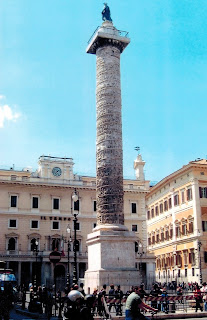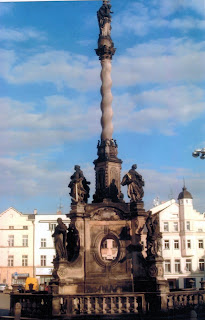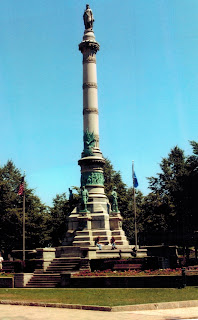 |
| Cy Twombly, Ferragosto IV, 1961. |
The canvases of Cy Twombly now sell in the tens and hundreds of millions of dollars, but that doesn't make them easy to understand, appreciate, enjoy, or like. The content of these canvases can seem like scribbling, or markings, or doodles, or tracings, lacking in any obvious meaning. Twombly himself hasn't been of much help in deciphering or explaining his work; he gave few interviews and was a deeply private person, committed to his art but not to helping the art world--or ordinary folks--understand it.
Why should we care about Twombly at
Rome the Second Time? Because, as we learned from Joshua Rivkin's important new book,
Chalk: The Art and Erasure of Cy Twombly (2018), Twombly spent significant periods of time living and working in Italy--in Gaeta, Bassano, Grottaferrata, Sperlonga and, especially, Rome, which he once described as "home." (We first wrote about
Twombly and Rome in 2009 in a post appropriately titled, "Twombly and us in Rome.")
Twombly was about as far from Italian as one can get. He was born in Lexington, Virginia, deep in the Shenandoah Valley, on April 25, 1928. He valued the area, including the nearby Civil War battlefields, and he maintained a studio in Lexington. He studied painting as a teenager, learned more at the Art Students League in New York City and at avant-garde Black Mountain College, where he and Robert Rauschenberg were fellow students, friends, and lovers.
 |
| Cy, photographed by Rauschenberg, 1952 |
"When I grow up I'll go to Rome," Twombly is said to have remarked, and in September, 1952 he made it there, with Rauschenberg, who photographed him beside the enormous hand of Constantine in the Capitoline museum and on
the steps of the Basilica di Santa Maria in Aracoeli.
They stayed for 6 weeks, living in a pensione, Twombly wrote, "overlooking the Piazza di Spagna a block from via Margutta where most of the important contemporary painters and sculptors have studios." Rome was attractive for many reasons, not least, as
novelist John Cheever wrote, because "no one cares" about two men living together.
For two days he walked the city, then bought materials and set to work, while continuing to experience Rome's pleasures. Consistent with his canvases, Twombly became something of a scavenger (or a collector if you will), haunting Rome's flea markets, including one "in a little Piazza del something or other" (Rauschenberg's words), purchasing marble busts and Etruscan relics brought in from the countryside. "He just went crazy," an irritated Rauschenberg added.
 |
| Sosos, "Unswept Room" |
At the Vatican museum, Twombly discovered the Sosos mosaic (above) known as the "unswept room," which included a pea pod on the floor. In 1957, Twombly wrote, "One must desire the ultimate essence even if it is," like the pea pod, "contaminated." "The discarded," Rivkin adds, "is picked up and turned into art in the mosaic, as in Twombly's work....Twombly gathers debris into his work: the debris of history, the debris of quoted poems, the debris of the body, the debris of the mind."
The art world did not at first respond positively. Twombly returned to the US in the spring of 1953, working in New York toward a 1953 show that would include his Rome production and other paintings done in and about Morocco. One critic wrote that the paintings "resemble graffiti, or the drawings of pre-kindergarten children." Another wrote, "to read an intelligible or communicable meaning into them is impossible. The best thing to be said is that they apparently render the artists's sensations convincingly."
 |
| Cy in 1959 |
In February 1957 Twombly returned to Rome and environs, this time at the urging of Italian painter Toti Scialoja. For two months he lived and painted in the Colli Albani town of Grottaferrata, staying with a woman friend who facilitated introductions to Rome's art world, then moving into the city proper.
There, in a studio across from the Coliseum, he painted Blue Room, Sunset, Olympia and Arcadia--"tender open canvases," as he described them. He met Willem de Kooning and the Italian artist Afro in Rome, but found the gallery scene "nil" and added, "there is little chance of my selling here."
 |
| Twombly, "Olympia" |
So it was back to New York City, but only briefly. In early 1959 he married Luisa Tatiana Franchetti in a ceremony in New York, then returned to Rome for a 2nd ceremony. He would remain there for most of the next decade. Not yet a real success, he had a show at Galleria La Tartaruga--a meeting place for artists in Rome.
His wife Tatiana came from money, and she used it to purchase a 17th-century Rome palazzo, where the couple lived and Twombly did some of his work (he also rented a studio on Piazza del Biscione).
 |
| Cy at the via di Monserrato palazzo, 1966 |
The palazzo was near Piazza Farnese on via Monserrato. Seeking privacy and as much silence as the location would afford (there was a restaurant below), he covered the windows with upholstery. Working in the heat of August at the Biscione studio, he did a series of 5 Ferragosto paintings ("Ferragosto" is Italy's mid-August holiday), "cartoonish and serious," Rivkin writes, "anxious and wild, layered and dirty, a sequence that mirrors his state of mind and his home of Rome."
 |
| From the "Ferragosto" sequence |
Returning from a brief sojourn in New York, Twombly returned to Rome in 1966, accomplishing what Rivkin describes as "the best paintings of his life"--the blackboard paintings--characterized by the "illusion of legibility," derived, perhaps, from hour-long walks in the city. The paintings, write Rivkin, "offer an unending trace that speaks in an illegible tongue," the "after life of [Jackson] Pollock, the tradition which Twombly seems...to be in conversation with."
 |
| Right, from the "Blackboard" sequence, here at MOMA |
Twombly was in and out of Rome for the next 40 years, spending time in Bolsena and Gaeta as well.
He disliked what Rome had become. "It's wall to wall," he wrote of the Rome of 2000. "If I went to Rome now, I wouldn't spend two days. But when I went I was in paradise." Still, anticipating death he returned to Rome, visiting t
he graves of Shelley and Keats in the Protestant cemetery. He died in a Rome hospital on July 5, 2011.
Rivkin's passionate book is, among other attributes, a remarkable effort to penetrate Twombly's consciousness (or unconsciousness), including his relationship to Rome. In search of Twombly, Rivkin interviewed everyone he could find that knew the artist. More than that, he spent months walking Rome's streets, trying to see what Twombly had seen, to feel what he had felt.
"So many Romes," writes Rivkin. "And yet, there is really just one. The Rome that exists in the mind, neither city nor site nor space, but something wild and uncontainable." In Rome, Rivkin continues, "material is everywhere. In the display cases of museums, on the graffiti-marked walls of apartment buildings, in the hurry of train stations where the cars arrive off-schedule, in lovers arguing at intersections....High and low. Past and present."
 |
A typical messy Rome wall--this one, actually, in nearby Frascati in the Colli Albani.
Photo © by William Graebner. |
That's the second reference in this post linking Twombly's work to graffiti--and there's more. "Twombly," writes Rivkin, "erases away the surface by building it up, a process of accretion and layering and crossing out, pencil or paint, not unlike how a city wall accumulates--like graffiti over posters over brick, over and over, or for that matter, a life."
 |
Could be Twombly, but it's just a messy Rome wall, layered with graffiti (2018).
Photo © by William Graebner. |
Growing up, Twombly had scribbled graffiti-like messages on the basement walls of his home, and Rivkin, walking the streets of contemporary Rome, speculates that Twombly must have been inspired by what he found on the surfaces of the city. "The endless graffiti," Rivkin writes, "cocks, love notes, political slogans--on the sidewalks and walls, on bridges and iron grates shuttering the cafes at night, as ever-present now as when he first walked those streets."
 |
| Layering, Rome 2018. Photo © by William Graebner. |
We are skeptical that the Rome walls of today closely resemble those of the early and mid-1960s, when Twombly was working there; as an important, dominant form of urban conversation, graffiti emerges only in the 1970s, and a look at photo books of Rome in the 1950s and 1960s does not reveal much graffiti. Nonetheless, Rome has never been lacking in the sort of visual and historical complexities and layerings that intrigued Twombly. Graffiti aside, Rivkin's analysis cannot be far from the truth.
There is a plaque to Twombly, mounted on a marble pillar near the entrance to Chiesa Nuova, where his funeral was held. Another Rome site of note is
the Gagosian Gallery. Twombly's "III Notes from Salalah" inaugurated the gallery in 2007.
 |
| The 2007 Gagosian exhibition of Twombly paintings. |
Bill
More "found art" photos by William Graebner at
www.foundartphotos.com.




























